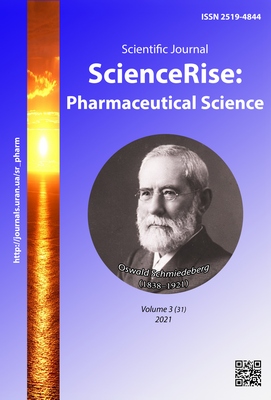Synthesis and antimicrobial activity of s-substituted derivatives of 1,2,4-triazol-3-thiol
DOI:
https://doi.org/10.15587/2519-4852.2021.235976Keywords:
1,2,4-triazole, antibacterial activity, antifungal activityAbstract
The aim of the work. 1,2,4-triazole derivatives possess a wide range of pharmacological activity, so they are used for the development of drugs and active pharmaceutical ingredients. Due to the reactivity of 1,2,4-triazoles there are many options for their further structural modification on different reaction centers. Therefore, the aim of the work was to obtain new S-substituted derivatives of 1,2,4-triazole-3-thiols, study physicochemical parameters of the substances synthesized, evaluate the antimicrobial activity of new S-derivatives of the 4-R1-5-((3-(pyridin-4-yl)-1H-1,2,4-triazol-5-yl)thio)methyl)-4H-1,2,4-triazole-3-thiol series, and study some regularities of the “structure – biological activity” relationship for the synthesized compounds as well.
Materials and methods. The subject of the study was new S-substituted 1,2,4-triazoles containing 2-oxopropan-1-yl and 2-aryl-2-oxoethan-1-yl substituents. The antimicrobial activity was studied by double serial dilutions on test cultures of Staphylococcus aureus (ATCC 25923), Escherichia coli (ATCC 25922), Pseudomonas aeruginosa (ATCC 27853), and Candida albicans (ATCC 885-653).
The results of the biological screening showed that at a concentration of 125 g/mL, all synthesized substances showed activity (MIC – in the range of 31.25 - 62.5 μg/mL, MBCK - in the range of 62.5–125 μg/mL) against strains of Escherichia coli, Staphylococcus aureus, Pseudomonas aeruginosa, Candida albicans. Variation of substituents on the sulfur atom did not lead to a significant change in antimicrobial and antifungal activities among derivatives of 4-R1-5-((3-(pyridin-4-yl)-1H-1,2,4-triazole-5-yl) thio)methyl)-4H-1,2,4-triazole-3-thiols.
Conclusions. Biological screening data indicate the prospects for the search for new antimicrobial substances among the abovementioned derivatives of 1,2,4-triazoles. The most active compounds were 1-((4-ethyl-5-((3-(pyridin-4-yl)-1H-1,2,4-triazol-5-yl)thio)methyl)-4H-1,2,4-triazol-3-yl)thio)propan-2-one and 1-(4-methoxyphenyl)-2-(4-ethyl-5-(((3-(pyridin-4-yl)-1H)-1,2,4-triazol-5-yl)thio)methyl)-4H-1,2,4-triazol-3-yl)thio)ethanone, which showed the most pronounced antimicrobial activity against the Pseudomonas aeruginosa strain (MIC – 31.25 μg/mL, MBcK - 62.5 μg/mL)
References
- Serwecińska, L. (2020). Antimicrobials and Antibiotic-Resistant Bacteria: A Risk to the Environment and to Public Health. Water, 12 (12), 3313. doi: http://doi.org/10.3390/w12123313
- Boraei, A. T. A., El Ashry, E. S. H., Duerkop, A. (2016). Regioselectivity of the alkylation of S-substituted 1,2,4-triazoles with dihaloalkanes. Chemistry Central Journal, 10 (1). doi: http://doi.org/10.1186/s13065-016-0165-0
- Safonov, A. A. (2018). Study acute toxicity of 4-(R-amino)-5-(thiophen-2-ylmethyl)-4H-1,2,4-triazole-3-thiol in vivo. Farmatsevtychnyi Zhurnal, 2, 98–101. doi: http://doi.org/10.32352/0367-3057.2.16.06
- Bihdan, O. A., Parchenko, V. V. (2018). Synthesis and physical-chemical properties of some 5-(3-fluorophenyl)-4-methyl-1,2,4-triazole-3-thiol derivatives. Farmatsevtychnyi Zhurnal, 2, 38–47. doi: http://doi.org/10.32352/0367-3057.2.17.05
- Chaudhary, P. M., Tupe, S. G., Jourwekar, S. U. et. al. (2015). Synthesis and antifungal potential of 1,2,3-triazole and 1,2,4-triazole thiol substituted strobilurin derivatives. Indian Journal of Chemistry, 54 B, 908–911.
- Parchenko, V. V., Parkhomenko, L. I., Izdepskyi, V. Y., Panasenko, O. I., Knysh, Ye. H. (2013). Pharmacological and biochemical characteristics of piperidine 2-(5-furan-2-yl)-4-phenyl-1,2,4-triazol-3-iltioacetate. Zaporozhye Medical Journal, 1, 39–41.
- Rao, D. V. N. (2015). Synthesis, Characterization and Antimicrobial Evaluation of Substituted 1,2,4-Triazole Thiones Containing Pyrazole Moiety. Journal of Clinical and Analytical Medicine, 6 (5). doi: http://doi.org/10.4328/jcam.2323
- Saadeh, H. A., Mosleh, I. M., Al-Bakri, A. G., Mubarak, M. S. (2010). Synthesis and antimicrobial activity of new 1,2,4-triazole-3-thiol metronidazole derivatives. Chemical Monthly, 141 (4), 471–478. doi: http://doi.org/10.1007/s00706-010-0281-9
- Metodychni vkazivky 9.9.5-143-2007 «Vyznachennia chutlyvosti mikroorhanizmiv do antybakterialnykh preparativ» (2007). Kyiv: MOZ Ukrainy, 63.
- Ding, Y., Zhang, Z., Zhang, G., Mo, S., Li, Q., Zhao, Z. (2015). Green synthesis and evaluation of the antitumor activity of a novel series of 3-[4-bi-(4-fluorophenyl)methylpiperazinyl]-4-amino-5-thione-1,2,4-triazole Schiff bases. Research on Chemical Intermediates, 42 (4), 3105–3116. doi: http://doi.org/10.1007/s11164-015-2200-5
- Perekhoda, L. A. (2014). Assessment of Quantitative Structure-Anticonvulsive Activity Relationships in a Series of Derivatives of 1,2,3-Triazole(1H), 1,2,4-Triazole(4H), 1,3,4-Oxadiazole(1H), and 1,3,4-Thiadiazole(1H). Pharmaceutical Chemistry Journal, 47 (11), 586–588. doi: http://doi.org/10.1007/s11094-014-1012-z
- Gotsulya, A. S., Mikolasyuk, O. O., Panasenko, O. I., Knysh, Ye. G. (2014). Synthesis and investigation of the physicochemical properties of 2-(5-((theophylline-7'-yl)methyl)-4-phenyl-4H-1,2,4-triazole-3-ylthio)-acetic acid salts. Zaporozhye Medical Journal, 1, 91–94. doi: http://doi.org/10.14739/2310-1210.2014.1.23820
- Volyanskiy, Yu. L., Gritsenko, І. S., Shirobokov, V. P. et. al. (2004). Vivchennya spetsifіchnoi aktivnostі protimіkrobnikh lіkarskikh zasobіv. Kyiv: DFTS MOZ Ukraini, 38.
- Hotsulia, A. S., Knysh, Y. H. (2020). Synthesis, structure and properties of 7-((4-amino-5-thio-1,2,4-triazole-3-yl)methyl)-theophylline derivatives. Current Issues in Pharmacy and Medicine: Science and Practice, 13 (2 (33)), 176–184. doi: http://doi.org/10.14739/2409-2932.2020.2.207019
- Bihdan, O. A., Parchenko, V. V. (2017). Physical-chemical properties of 5-(3-fluorophenyl)-4-amino-1,2,4-triazole-3-thiol s-derivatives. Current Issues in Pharmacy and Medicine: Science and Practice, 10 (2 (24)), 135–140. doi: http://doi.org/10.14739/2409-2932.2017.2.103517
- Zamani, K., Faghihi, K., Sangi, M. R., Zolgharnein, J. (2003). Synthesis of some new substituted 1,2,4-triazole and 1,3,4-thiadiazole and their derivatives. Turkish Journal of Chemistry, 27, 119–125.
- Davari, M. D., Bahrami, H., Haghighi, Z. Z., Zahedi, M. (2009). Quantum chemical investigation of intramolecular thione-thiol tautomerism of 1,2,4-triazole-3-thione and its disubstituted derivatives. Journal of Molecular Modeling, 16 (5), 841–855. doi: http://doi.org/10.1007/s00894-009-0585-z
- Datoussaid, Y., Othman, A., Kirsch, G. (2012). Synthesis and antibacterial activity of some 5,5’-(1,4-phenylene)-bis-1,3,4-oxadiazole and bis-1,2,4-triazole derivatives as precursors of new S-nucleosides. South African Journal of Chemistry, 65, 30–35.
Downloads
Published
How to Cite
Issue
Section
License
Copyright (c) 2021 Yevhen Karpun, Nataliia Polishchuk

This work is licensed under a Creative Commons Attribution 4.0 International License.
Our journal abides by the Creative Commons CC BY copyright rights and permissions for open access journals.








